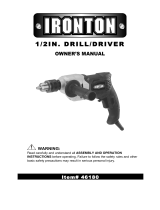
Page 11For technical questions, please call 1-888-866-5797.Item 60495
SAFETYOPERATIONMAINTENANCE SETUP
General Operating Instructions
1. Make sure that the Trigger is in the
off-position, then plug in the tool.
2. Set Direction Switch to desired position.
• For clockwise (forward) rotation,
push it from right side.
• To for counterclockwise (reverse)
rotation, push it from left side.
NOTICE: Do not change rotation direction
while the Chuck is rotating.
3. Press Trigger to activate.
4. For continuous drilling, press Trigger, then Trigger
lock button on side of handle, and release Trigger.
To release lock, briefly depress Trigger.
CAUTION! Use this continuous drill function ONLY
when drilling soft materials.
Do not drill or hammer drill hard materials such as
steel or concrete with Lock Button pressed (ON).
If drill bit catches on material, the high torque will
cause the tool to twist around without stopping.
WARNING! Use both hands during use.
5. Use the Depth Gauge for controlled depth drilling.
Gauge markings are general guides,
not precise values.
6. Insert bit and tighten Chuck. Loosen Side Handle,
place tip of bit against solid surface and extend
Depth Gauge until it is against same surface.
Determine required hole depth and retract
Gauge accordingly. Tighten Side Handle.
7. To switch between plain drilling and
hammering mode
(drilling with an oscillating hammer motion),
slide the Mode Selector to left or right.
The “drill” symbol indicates plain drilling while
the “hammer” symbol indicates hammer drilling.
8. To prevent accidents, turn off the tool and
unplug it after use. Clean, then store the
tool indoors out of children’s reach.
Metal Drilling Tips
1. Use high speed steel, carbide or
specialty bits for metal drilling.
2. Secure workpiece to keep it from moving
during the drilling operation.
3. Use a center punch (not included) to
create a dimple for the bit to start.
4. Start by drilling slowly to keep bit from wandering/
skating away from your starting point.
5. As hole is established, increase speed.
Do not use so much pressure that bit heats up.
This can damage bit and create irregular hole.
For hard metal, use cutting oil to keep bit cool.
6. When drilling large holes in metal,
start by drilling a smaller pilot hole,
then using a larger bit for the final size hole.
Wood Drilling Tips
1. Use high speed bits or bits specially
designed for wood drilling, such as
brad point, spade bits, forstner bits, etc.
2. Secure work piece to keep it from moving
during the drilling operation.
3. Start by drilling slowly to keep bit from
wandering away from starting point.
Increase speed as hole is established.
4. To prevent or reduce “break out” when bit
penetrates work piece, clamp a piece of
scrap material to back of work piece.
5. Do not lock Trigger in the ON position,
as the bit can easily jam in wood and
motor must be stopped quickly.
Concrete Drilling Tips
1. Do not apply excessive force, allow
the tool to do the work.
2. Do not add water to the drill hole.
3. Clean the bit flutes regularly while drilling.
4. Back the bit out of the hole often during drilling,
especially when drilling deep holes.
5. Use the shortest bit practical.
6. When drilling deep holes, work in stages,
use a short bit for the beginning of the hole,
then change to a longer bit.

















